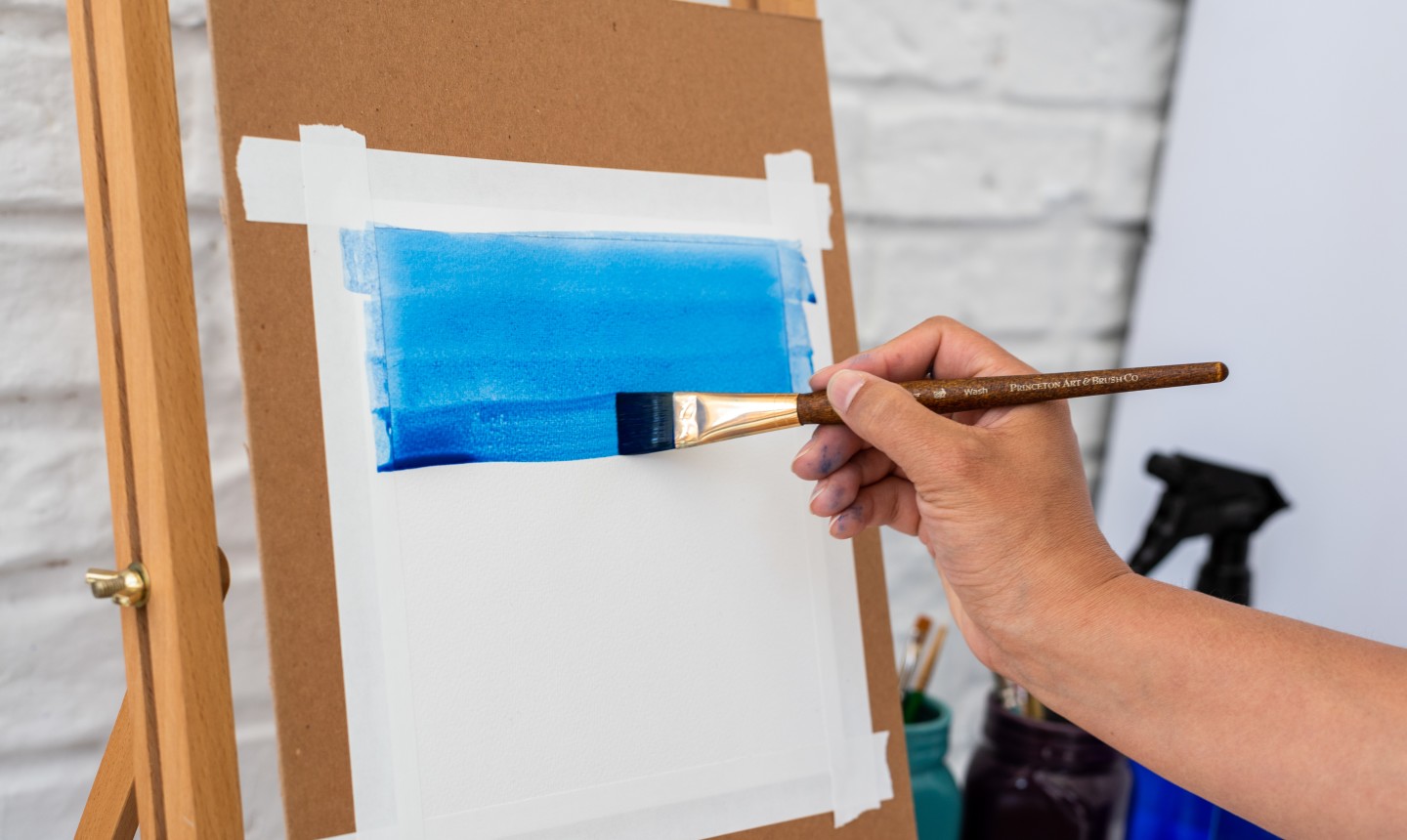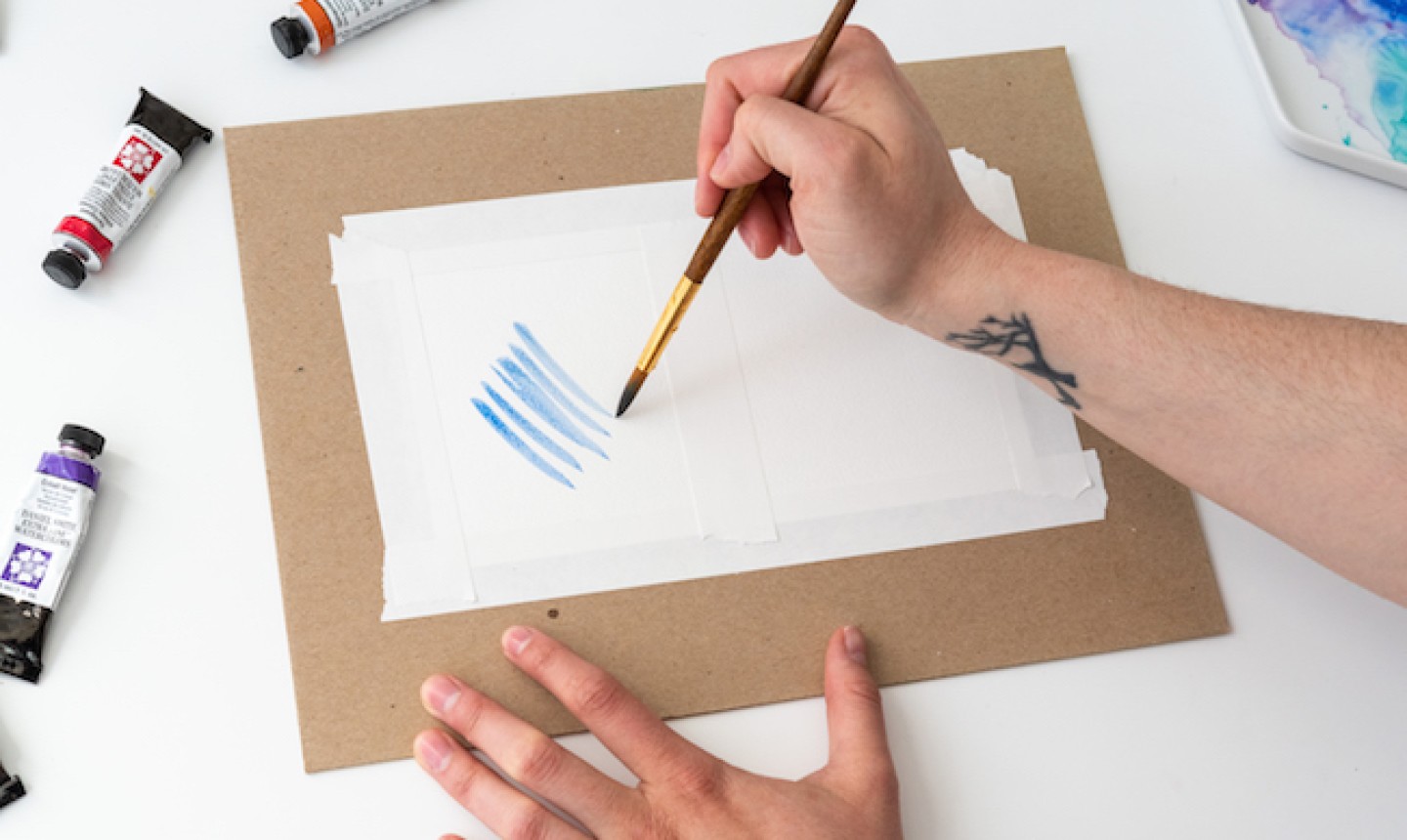
Using the right (or wrong) type of paper can truly make or break your painting, and there’s no better feeling than finding the perfect one for your project. If you’re just getting started in the realm of watercolor — or you’ve just never tried different varieties — there are a few things to consider before picking up your paint brush.
Texture
In the world of watercolor paper, there are two main factors to consider: texture and weight. Texture directly impacts each brushstroke, and the below options provide different styles to help create the look you want.
Hot-Pressed Paper
As the name suggests, this paper is pressed using metal rollers to create a smooth surface and even texture. This makes it great for mixed media work: ink, even graphite, will glide smoothly over the surface.
Hot-pressed paper also captures detail well and offers a sleek finish. And because it’s so smooth, the paper is great for creating subtle color gradients, which comes in handy when painting flowers, clothing, skin tones and skies.
Cold-Pressed Paper
This watercolor paper has a rougher texture than its hot-pressed counterpart, so when you glide your brush over it, some of the paint settles while skipping the indentations of the grainy texture, leaving them blank.
This creates a beautifully textured brushstroke, perfect for representing sparkling bodies of water. Cold-pressed paper is also great for beginners and is a favorite among many artists.
Rough Paper
As you can imagine, rough paper has a very textured surface, so it won’t work best for detailed paintings. Instead, it helps create expressive brush strokes that can provide character and emotion to a painting. It’s a fun texture to work and experiment with, as you never really know what the results will be.
Weight

All three textures of watercolor paper come in different weights. The heavier the weight, the sturdier (and pricier) the paper. Fun fact: the weight is determined by the actual weight of 500 sheets of 20″ x 30″.
90 lb paper: This is quite thin and a weight that needs to be stretched. It’s more suited for studies and training.
140 lb paper: The most commonly sold, this weight also needs to be stretched.
300 lb paper: More like cardboard, this doesn’t require any stretching. While it’s sturdy, it is expensive and takes longer to dry.
Choosing the Right Paper for You

Here’s the thing to remember: no type of paper is inherently better than the other. It all depends on your needs, your preferred watercolor techniques and what look you’re going for in the painting. Which is why Kateri Ewing, fine artist and Bluprint instructor of Startup Library: Painting With Watercolors, developed a testing system to help you quickly assess if a type of paper will work well with your personal painting style.
1. Erasability
Can you easily remove graphite without damaging the surface of the paper? This is important if you begin your paintings with a sketch and make adjustments with an eraser.
To test your paper, draw a thin rectangle and fill it in with an HB or number 2 pencil. Use a hard white eraser to remove a section of graphite, then feel the paper for any roughness. Notice how well the graphite disappears and whether the paper holds on to the eraser debris.
2. Pigment Over Eraser Marks
If you use a pencil, even very lightly, you want to be sure that paint won’t settle into the erased lines. So draw an X on the paper and erase it. Paint a layer of watercolor pigment over the place where you erased the X.
If the paint settles into the grooves, the paper is too soft. If the paper looks abraded or rough in any way, the surface may not be strong enough to hold up to some painting techniques.
3. Clean Edges
If your painting requires clean, sharp lines, make sure your paper will maintain them. Some papers tend to let paint seep around the edges, no matter how careful you are.
For this test, draw a square shape with your paint and fill it in with the same paint. When it dries, it should maintain the edges without allowing any seepage. If it does, you know you haven’t found the right one just yet.
4. Smooth Washes

The ability to hold a smooth wash is incredibly important. Student-grade papers often absorb the paint too quickly, leaving you with streaks and an uneven wash. Most artist-grade papers take washes very well, but it’s still worth testing.
Make a juicy wash, then use a pointed round brush to pull the wash down, in rows, from left to right, always picking up the bead that has formed from the row before. Let it dry, then check for streaks and pooling.
5. Flow
If you paint wet-on-wet or use water glazes, the paper needs to have good flow — meaning when you add more pigment or drop color into a water glaze, it should flow well over the surface.
Paint a rectangle with clear water, then drop pigment in the upper right corner. If it starts to move across the water glaze, it has good flow. Look at it after it dries to see if it’s migrated well across the rectangular water glaze.
6. Lifting When Wet
Color should lift easily with a clean, damp brush, and the highlight should remain without too much of the paint seeping into the area where it’s been removed. To test, paint a rectangle, let it settle for a moment, then use the tip of a clean, damp brush to lift some of the pigment.
7. Lifting When Dry
You also want the paper to stand up to lifting techniques once the paint has dried. The paint should lift off where you scrub it and not leave the paper abraded.
Paint a rectangle and let it dry completely. Swipe a clean, damp brush in a small line back and forth in the center of the paint swatch, about eight times. Then dab it with a clean tissue and see how the pigment reacts.
8. Holding a Mark

It’s vital that paper holds your marks crisply. For this test, pick up paint with your brush and make swift X marks or random lines. When dry, the edges should be crisp, with no seepage.
Think Beyond Paper
Believe it or not, paper isn’t the only canvas for gorgeous watercolor paintings.
Yupo
Yupo is a synthetic paper made from polypropylene that offers a watercolor-friendly work surface. Because it’s waterproof, the paint dries only by evaporation, creating really nice textures in the process. And if you make a mistake, yupo lets you easily wipe it off (as long as the colors are not staining).
Illustration Board
This material is really thick and sturdy, so it can hold a lot of water. It also scans easily, making it ideal when creating digital reproductions of your art.
Like watercolor paper, it comes in hot-pressed and cold-pressed varieties, but the texture is less pronounced. This means it’s a better option for mixed media, from pen and ink to pencil. It’s also great for incorporating other types of paint, such as gouache or acrylic.
Bristol Board
Bristol board is a multimedia surface that falls somewhere between illustration board and drawing paper in thickness. It comes in two primary finishes: vellum (which is lightly textured and has a gentle “tooth” to the texture) and smooth (which isn’t as absorbent, making it less suited to watercolors).
A vellum Bristol board is less absorbent than watercolor paper, but far more so than a typical drawing paper. And because Bristol board is typically a slightly thicker paper stock, light watercolor washes typically won’t warp it. If you work fairly small in scale or have a light hand with your watercolor, vellum Bristol board may be a good pick. (Alternatively, it can be a good choice for practice paintings before moving on to more finished pieces on pricier and thicker watercolor paper.)
Watercolor Art Board
Watercolor art boards, such as Aquabord, offer a unique alternative to watercolor paper on an elegant, interestingly textured surface. They’re an archival, acid-free, gently textured clay surface that have the ability to absorb watercolor paints like paper and allow the watercolor to retain a full vibrancy. These boards can be pricey, but they’re worth experimenting with if you have the chance. Plus, they don’t need to be stretched and won’t tear, shrink or buckle.
Canvas
In general, canvas isn’t a suitable medium for most watercolor paintings. Because it’s usually primed for acrylic and oils, it’s not very absorbent and doesn’t hold watercolor paint well. That said, you can try using canvas for more abstract watercolor pieces — it will be a little messy and flowy, but that’s part of the fun. Just use an old brush, as the canvas may not be nice to your delicate watercolor brushes.

Understanding a lot of information and how to find the best watercolor paper for beginners will help https://allpaperworld.com/.
I like self study. I have spent four years in acrylics and now want to try some watercolor. Craftsy Browse has been a great primer to get me started.